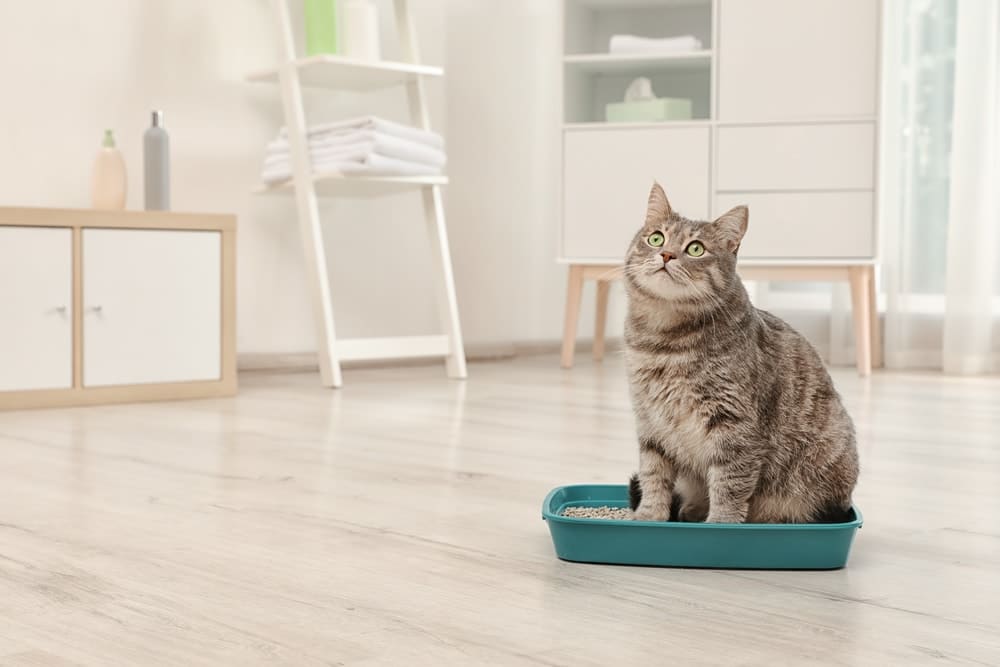
If your cat is urinating outside the litter box, straining to urinate, urinating frequently, yowling when urinating, or has blood in the urine, it could mean they have a urinary tract infection (UTI). Urinary tract infections are common, painful and they can progress rapidly. Especially among male cats, urinary tract infections can also lead to urinary blockages, which are very dangerous.
Quick Overview: Urinary Tract Infections In Cats
 Other Names: UTI
Other Names: UTI
 Common Symptoms: Urinating outside the litter box, urinating more frequently than normal, straining to urinate/urinating tiny amounts, vocalizing when urinating, blood in the urine, excessive grooming of the groin/genital area.
Common Symptoms: Urinating outside the litter box, urinating more frequently than normal, straining to urinate/urinating tiny amounts, vocalizing when urinating, blood in the urine, excessive grooming of the groin/genital area.
 Diagnosis: Urinalysis, urine culture and antibiotic sensitivity, ultrasound, bloodwork as well in more advanced cases, x-rays if bladder stones are also suspected.
Diagnosis: Urinalysis, urine culture and antibiotic sensitivity, ultrasound, bloodwork as well in more advanced cases, x-rays if bladder stones are also suspected.
 Requires Ongoing Medication: No
Requires Ongoing Medication: No
 Vaccine Available: No
Vaccine Available: No
 Treatment Options: Antibiotics, pain medication.
Treatment Options: Antibiotics, pain medication.
 Home Remedies: None. Cranberry and vitamin C supplements are unlikely to stop a urinary tract infection. Evidence for helping with prevention of recurrent infections is variable.
Home Remedies: None. Cranberry and vitamin C supplements are unlikely to stop a urinary tract infection. Evidence for helping with prevention of recurrent infections is variable.
A urinary tract infection can affect any portion of the urinary tract, including the kidneys, ureters, and bladder, though it most commonly refers to an infection in the bladder. Cats get urinary tract infections when bacteria (or, rarely, fungi) colonize the bladder.
Bladder infections fit in the broad category of ‘feline lower urinary tract disease’ (FLUTD). Other common manifestations of FLUTD include urolithiasis (urinary stones), crystalluria (microscopic crystals in the urine), urethral obstruction, and feline idiopathic cystitis (FIC).
What Causes Urinary Tract Infections in Cats?
Infection usually occurs when bacteria or other infectious agents enter the urine in the bladder through the urethra, which is the tube that transports urine from the bladder outside the body.
Bacterial infection
Bacteria and other microorganisms can travel up the urethra into the bladder. Once in the bladder, they rapidly multiply, causing infection and inflammation. A common bacteria causing UTIs in cats is Escherichia coli.
Predisposing factors
Any cat can get a urinary tract infection, but there are some factors which make them more likely
- Older cats
- Female cats
- Cats with diabetes mellitus
- Cats with other urinary issues such as bladder stones
Symptoms of Urinary Tract Infections in Cats
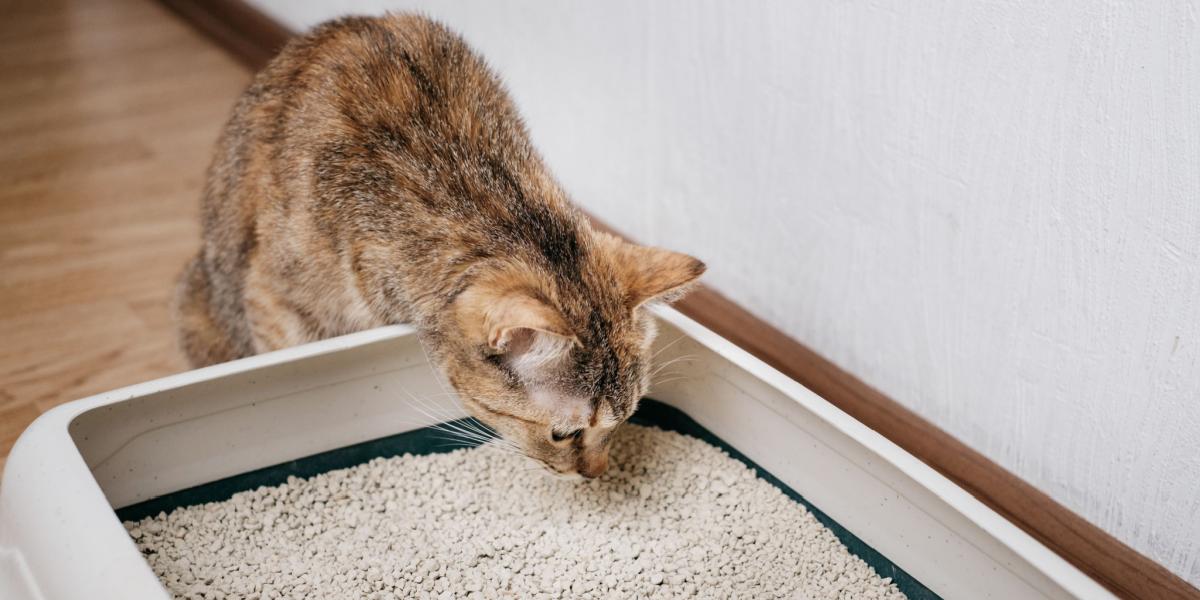
Urinary tract infections are most common in older female cats, Straining to urinate and going in and out of the litter box are typical warning signs
Cats tend to hide their illnesses, but paying close attention to your cat’s litter box habits can reveal some cat urinary tract infection symptoms, including:
- Urinating outside the litter box
- Frequent urination
- Straining to urinate/urinating small amounts
- Trying to urinate but not producing any urine
- Painful urination (crying/vocalizing when urinating)
- Blood in the urine
- Strong-smelling urine
- Overgrooming of genital area
Complications of Urinary Tract Infections
Some cats that develop bladder infections also have kidney bladder stones. Also called uroliths, bladder stones form from minerals in the urine, first into crystals and then stones. Uroliths are solid and often feel like sand or small pebbles, though some can grow to an inch or more in diameter.
Crystals and stone formation can cause inflammation, pain and damage to the urinary tract. Both bladder stones and crystals in the urine can lead to a urethral obstruction, commonly referred to as a urinary blockage.
With a partial urinary blockage, the cat may only be able to urinate small amounts. A complete urinary blockage occurs when urine cannot pass through the urethra at all. Because the urine cannot pass through the urethra, it remains in the bladder, which expands painfully. When it cannot expand any more, the kidneys can no longer process urine, leading to a buildup of toxins in the blood.
This is an extremely dangerous medical emergency. Without prompt treatment, a blocked cat could die. Male cats are at higher risk of experiencing a urinary blockage because their urethra is both longer and narrower than a female cat’s urethra.
Diagnosis of a Urinary Tract Infection
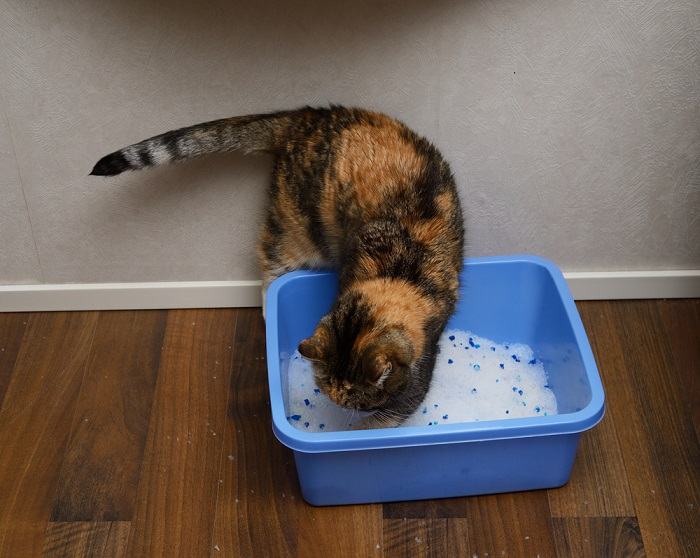
Non-absorbable cat litter can be used to get a urine sample from cats
If you notice any cat urinary tract infection symptoms, it’s important to seek immediate veterinary care. If you’ve ever had a UTI yourself, you know how painful it can be! It’s also important not to allow a urinary issue to go untreated. Urinary tract infections can progress rapidly, putting your cat’s health—and in the case of a urinary blockage, their very life—at risk.
If a urinary tract infection is suspected in your cat, the veterinarian will perform a physical examination and will also collect a urine sample to perform a urinalysis (comprehensive testing of the urine).
There are three ways to collect a urine sample:
- Cystocentesis: the veterinarian inserts a sterile needle through the skin and into the bladder to collect urine. This is the best way to get a sample without risking outside bacterial contamination that could complicate interpretation of the results of the urinalysis.
- Free-catch: cats who won’t tolerate a needle sample can be put into a cage with a clean litter box filled with a special non-absorptive litter, until they urinate.
- Catheter collection: the vet may insert a sterile urinary catheter (a very thin, long tube) through the urethra to collect urine. Unsurprisingly, this requires heavy sedation and is usually only done if your cat is being sedated for another reason.
Once the urine is collected, the vet will run tests on it, including viewing it under a microscope to look for bacteria and/or crystals. Alternatively, the veterinarian may send the urine sample off to a laboratory for testing.
A culture and sensitivity test can reveal if bacteria is present and also tell the vet exactly what type of bacteria it is and which antibiotic is most likely to be successful in treating it. This is important because different bacteria respond to different antibiotics.
If the veterinarian suspects your cat has bladder stones, x-rays or ultrasound may be recommended to confirm their presence. Depending on the symptoms your cat is showing, the vet may also recommend blood work.
Treatments for Urinary Tract Infections in Cats

Some urinary problems in cats benefit from dietary management.
Urinary infections usually resolve within a few days with appropriate treatment.
Treatment for a urinary tract infection in cats usually involves anti-inflammatory medications and/or pain medications, as well as antibiotics.
Exactly which antibiotic is used for cat urinary tract infections depends on the type of bacteria present. Since a urine culture and sensitivity test takes several days to run, your veterinarian may choose to start your cat on an antibiotic that is effective against the most common bacteria seen with urinary tract infections. If the urine culture shows the bacteria not sensitive to that antibiotic, your vet might switch your cat’s antibiotic if there has not been a good response to treatment.
Cat Care Tips
It’s never nice for a pet to be unwell, so here are some tips to help.
- Water: provide plenty of opportunities for your cat to drink, to flush out the bladder and urinary tract
- Seek advice early: urinary tract complaints are easier to treat if therapy is initiated promptly
- Litter trays: provide plenty of clean, quiet, private areas for your cat to toilet.
Prevention of Urinary Tract Infections
Urinary tract infections can be uncomfortable for our cats, and uncomfortable to witness as owners. So what can pet parents do?
Hygiene
Bacterial infections occur due to ascending infections. Provide plenty of litter trays, clean them out regularly and keep a close eye on your cat’s hygiene. Long-haired cats may need assistance in grooming, including keeping hair around their anus and genitals trimmed.
Diet
If your cat develops recurrent urinary tract infections or if he or she is also diagnosed with bladder stones or crystals, your veterinarian might recommend a diet change. Therapeutic urinary diets don’t treat infections, but aim to improve urinary health by limiting certain minerals, and adjusting your cat’s urinary pH to help prevent or reverse crystal and stone formation.
Also Read: Best Cat Food for Urinary Tract Health
Therapeutic cat food for urinary health is available with a prescription, either through your veterinarian or purchased online. If you’d rather not feed a prescription food, many companies now make over-the-counter diets for urinary health. There are also urinary supplements available to optimize cat urinary health. Always consult with a veterinarian before changing your cat’s diet or starting a supplement.
It’s also possible to use homemade cat food for urinary problems. Always work with a veterinarian or a veterinary nutritionist when feeding a homemade cat food, especially one intended to address specific health concerns like urinary tract infections and bladder stones.
Also Read: 6 Delicious Homemade Cat Food Recipes
Increase Water Intake
Some cats do not drink enough water. To increase water intake, feed your cat wet cat food instead of dry cat food and provide access to fresh, cool water. Pet fountains can also entice cats to drink more water.
Also Read: The 5 Best Cat Water Fountains
Home Remedies
Many cat owners worry about the cost of seeking veterinary treatment when their cat is ill. You might be tempted to search “cat urinary tract infection home remedies” and want to attempt to treat your cat’s urinary tract infection at home.
However, there are no home remedies that can resolve a bacterial urinary tract infection or address a serious urinary blockage. Cat urinary tract infection treatment and recovery will be easier (and likely less expensive) if you seek professional help early.
Frequently Asked Questions
Why is my cat going to the litter box every few minutes?
Frequent trips to the litter box indicate that your cat is struggling to toilet normally. If your cat keeps trying to pee but only a little comes out, it’s a sure sign that something is wrong. Bring him or her to the veterinarian as soon as possible.
If your cat keeps going to the litter box but nothing happens at all, he or she may be dealing with a complete urethral blockage. In this case, seek emergency veterinary care immediately. Just a few hours of hesitation could be fatal.
What should I do if my cat hasn’t peed in 2 days?
Go to the vet immediately. Get off your computer, pack up the carrier, get in the car, and go.
A cat who hasn’t urinated for 24 hours is at risk of becoming seriously ill. By that point, toxins in the bladder have started to seep into the rest of the body. By 48 hours, those toxins have been circulating for a long time, the bladder is excruciatingly full, and death is a very real possibility.
Why is there blood in my cat’s urine?
Bloody urine is usually a sign of inflammation or infection. If you notice blood in your cat’s urine, bring your cat to the veterinarian as soon as you can.
What if my cat is not peeing but is acting normal?
Urinary tract issues usually come with behavioral changes, but there are exceptions to this rule. If your cat can’t pee but is still eating, sleeping, and playing normally, you’re one of the lucky ones. You noticed the issue before it spiraled out of control.
But even without other signs of illness, a cat who isn’t peeing is at risk of serious health consequences. Bring your cat to a veterinarian as soon as you can.
How can I help my cat pee?
Bringing your cat to a vet is the single most reliable way to get your cat unblocked and able to pee again. Veterinarians have the tools and know-how to physically clear the blockage and get your cat back on the path to recovery.
A simple procedure could save your cat’s life. Anything else is a dangerous waste of time.




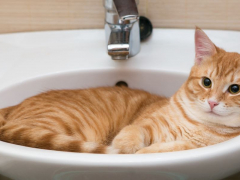

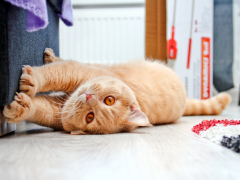

hi .my cat is on his third antibiotic for a uti it doesnt seem to be helping.can you give me any advice on what is happening and why it isnt clearing up thankyou
Daphne, unfortunately, I can’t give an exact answer to this question—a veterinarian who’s able to test and evaluate your cat physically would be better qualified. However, as a non-vet who can’t see your cat, I would encourage you to ask your vet if they have done a urine culture to determine that it is, in fact, a bacterial infection. Because it’s a simple solution, vets often prescribe antibiotics to cats who don’t necessarily have a urinary tract infection, before they’ve done a culture or other diagnostics. Because the antibiotic doesn’t seem to be working, I wonder if it’s not actually an infection. If your cat is still able to urinate, I would recommend supplementing the antibiotics with additional water (make sure he’s on wet food with additional water mixed in). You can also consider a diet specially formulated for urinary tract disease or one of the other recommendations on our list of the best cat food for urinary tract health. If he is not urinating at all, this is an emergency that must be treated within 24 hours. Catheterization may be necessary. Overall, I would recommend talking to your veterinarian to pinpoint exactly what is wrong with your cat and why the vet has chosen the treatment they have.